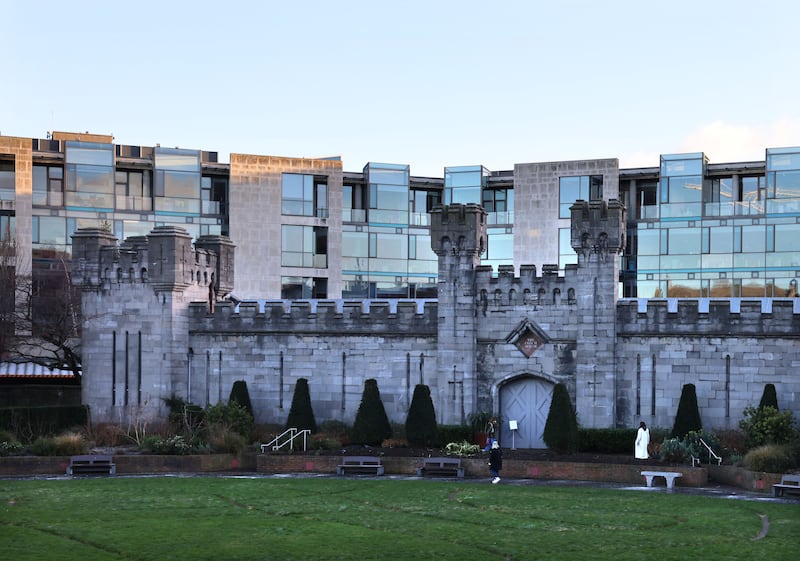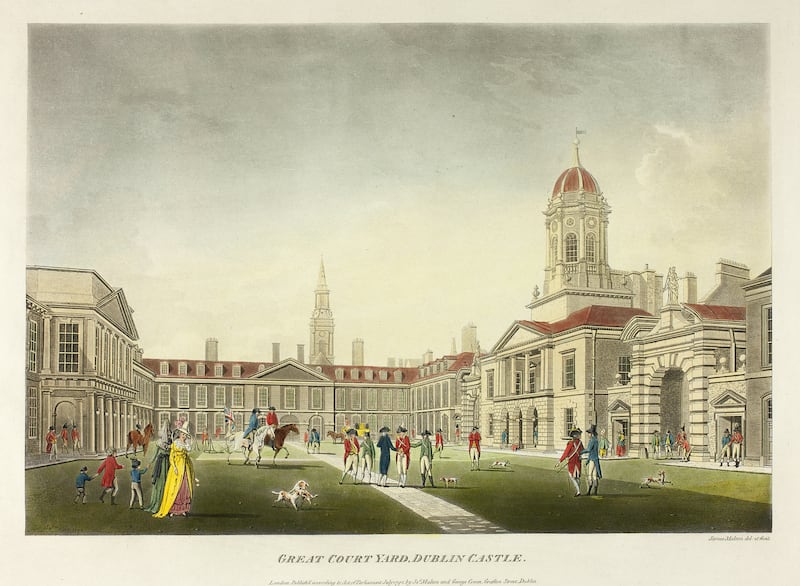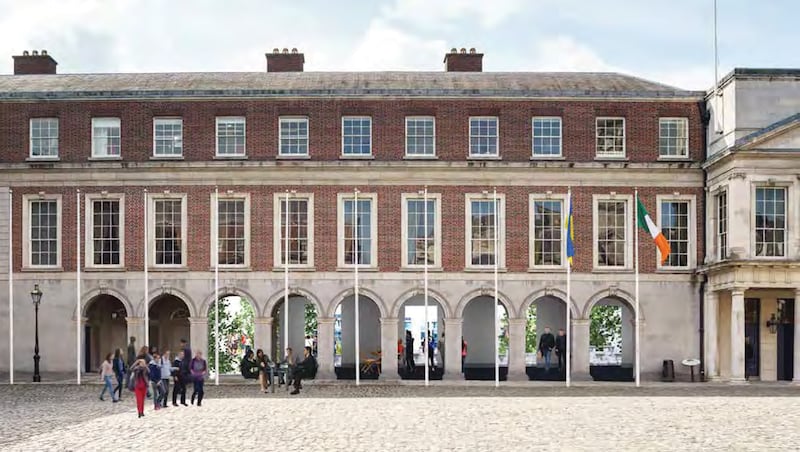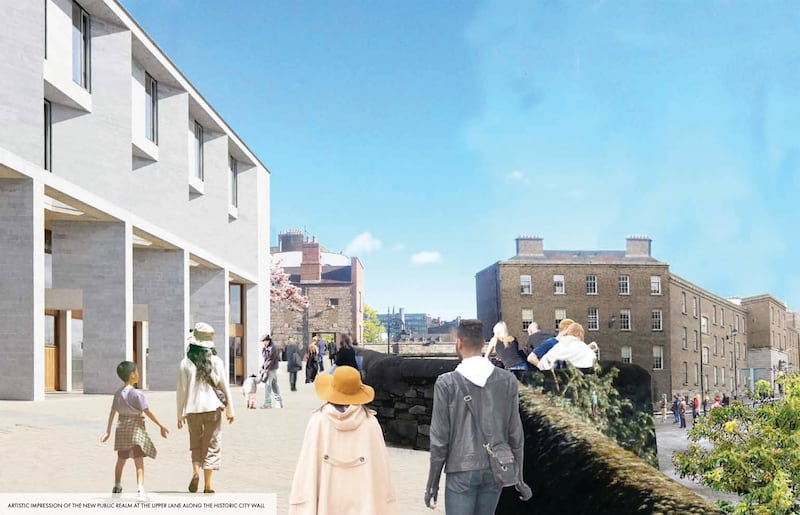Dublin Castle is unquestionably the most important historic precinct in the capital, and not just because it was the nerve centre of British rule in Ireland for centuries. It has also been the place where every president since Douglas Hyde has been inaugurated and the venue for State dinners, EU summit meetings, tribunals of inquiry and referendum-result celebrations.
Yet, for a complex so laden with history, it has been shabbily treated over the years – even by its custodian, the Office of Public Works. Indeed, the OPW was responsible for commissioning the aggressively modernist Stamping Building (1973) in Lower Castle Yard, replacing the castle’s demolished Guard House and stables and, irritatingly, aligned at an angle to its formal composition.
Objections by An Taisce and the Irish Georgian Society were blithely disregarded, as State developments were exempt from planning control at the time. Plan magazine poked fun at the four-storey block, with its running balconies redolent of hotel architecture on the Spanish costas: “Where is that Mediterranean sun and the bathing towels?” it asked derisively.
The strategic framework plan for Dublin Castle concedes that its development over the past century ‘happened piecemeal, as necessity required, and seldom with a sense of overall ambition’
The strategic framework plan for Dublin Castle, from 2022, concedes that its development over the past century “happened piecemeal, as necessity required, and seldom with a sense of overall ambition”, resulting in a campus that can “appear disjointed and, at times, illegible – a place that has unintentionally reinforced a sense of isolation from city and citizen”.
RM Block
For years Revenue officials working in Dublin Castle could park their cars in marked spaces all over Lower Castle Yard, a practice that was discontinued some time ago. But there are still private cars – seemingly owned mostly by members of the Garda metropolitan division still based at the castle – randomly parked along the back road leading to the Chester Beatty Library.
The European Hall and conference centre, completed in 1990, was the largest single intervention in the castle in recent decades. Designed by the senior OPW architects Klaus Unger and Angela Rolfe, it was for the most part discreetly installed amid the mainly 18th-century buildings, opening up the Fortitude Gate from Castle Street via a new humpback bridge.
However, an aerial photograph of the castle from the mid-1980s shows that there was extensive demolition of historic fabric, with only facades retained in some cases. Apart from its courtyard front, the block behind Dublin City Hall was demolished, including the galleried Chief Secretary’s Library; the records it held formed the basis of the Oireachtas library.
In a project overseen by the late David Slattery, this block was rebuilt to provide more office space at Dublin Castle for the Revenue after an archaeological excavation that revealed the 13th-century foundations of its Powder Tower as well as a set of steps that led down to the original moat and postern gate. It is now one of the highlights of the castle’s guided tours.

The southern perimeter of the castle was significantly altered by the development of Dunnes Stores’ headquarters along Stephen Street Upper. Designed by Arthur Gibney & Partners and completed in 2007, it looms up behind the neo-Gothic castellated facade of the 1832 Coach House, which serves as an art gallery as well as a press centre for EU summits.
Although the four-storey Dunnes Stores building is relatively modest in scale, it strikes a discordant note in views from the Dubh Linn Garden and the State Apartments. To screen it, the framework plan puts forward the radical idea of a constructed mound that would double as an elevated extension of the garden as well as provide extra car parking underneath.
The nearby Clock Tower Building (1820), designed by Francis Johnston as the Ordnance Office of Britain’s Royal Engineers, was extended in 1995 to house the Chester Beatty Library. The framework plan, led by Grafton Architects, proposes to extend it further to address a suggested new entrance to the castle from Stephen Street Upper, alongside Leitrim House.
The cupola-topped clock tower, with its beautiful peacock weather vane crafted by the sculptor Rachel Joynt, used to be seen against the western sky by everyone walking towards the Ship Street Gate – as it had been for two centuries. But not any more. Rising at the rear are the blue-tinted upper levels of a visually overbearing office block on Ship Street.


Designed by the Dublin-based Reddy Architecture + Urbanism, the new eight-storey building is a massive affront to the dignity and setting of Dublin Castle. It also competes for business with conference facilities in the castle, as the cheekily named Dublin Royal Convention Centre, where Fianna Fáil held its 81st ardfheis in November 2023, is located on its lower levels.
It pains me to write this, because Tony Reddy, who heads Reddy Architecture + Urbanism, has been one of my best friends since we were students at University College Dublin, just over 50 years ago. But my heart sank when I first saw steel framework for the upper levels of the block rising above the roofs of Ship Street Barracks and realised then how negative its visual impact would be on Dublin Castle.
The new block not only makes the clock tower visually disappear but also destroys the sense of place of the Castle Steps – “the dark, awe-inspiring flight of steps”, as the American artist Flora Mitchell described them in Vanishing Dublin, her 1966 book – that lead down from Castle Street to the Ship Street Gate, alongside the castle’s forbiddingly high boundary wall, which dates from 1807.
The three-storey gabled guard house arching over the steps is no longer in a commanding position but oversailed by a melange of red brick and blue-tinted glazing that now dominates the skyline as you descend from Castle Street. Inexplicably, this critical view was not included among the viewpoints for photomontages submitted with the planning application.
In 2018, after Luxor Investments – a company controlled by the Galway builder and developer Padraic Rhatigan – sought permission for the proposed development, State Architect Ciarán O’Connor expressed concern about its increased scale, compared with a previously approved scheme for the site, and urged that this “should be reconsidered and adjusted accordingly”.
Chief State Solicitor Maria Graham was concerned that the bigger office block being proposed would overlook its headquarters next door, saying “the nature of the documentation handled and processed in this office is of national importance and can extend to top secret papers, which if compromised from a privacy/security aspect could be problematic”.

Dublin City Council planners also had “serious reservations” about the increase in scale and the impact this would have on Dublin Castle, and they asked Luxor to “consider a reduction in overall height and bulk of the development to mitigate these concerns and to ensure that the development as proposed contributes in a positive manner to the cityscape”.
After all, the democratically adopted Dublin City development plan declares that “all new proposals in the inner city must demonstrate sensitivity to the historic city centre”, referencing Dublin Castle among the places requiring special consideration. Yet nowhere in the anonymous planner’s report recommending a grant of permission is this policy mentioned.
The report stated that setting back the upper floors had “considerably reduced the bulk and overbearing nature” of the eight-storey block and also its “impact from sensitive viewpoints within Dublin Castle” – which seems a delusional conclusion when even the visual assessment submitted on behalf of Luxor showed that it would have a “significant” impact on two of these views.
The office block is called One Le Pole Square, a name derived from the 12th-century church of St Michael Le Pole that stood on the site for several hundred years; an outline of its plan is marked in the paving of a new square between Ship Street and Chancery Lane. This could be counted as a “planning gain”, but it’s only open to the public during daylight hours.

Tony Reddy says Le Pole Square and the convention centre would inject life into an area that had been “dead for decades, with a landscape of dereliction and decay”. As we walked through the site and its surroundings, he disputed my contention that irretrievable damage had been done to the setting of Dublin Castle, saying: “I’m quite proud of what we have achieved here.”
Beside it is a new 153-bedroom hotel developed by Wavepoint, a company controlled by the former Panda Waste proprietor Eamon Waters. This seven-storey yellow-brick block, with identikit windows at every level above ground floor, was approved by An Bord Pleanála in May 2020, having been refused by Dublin City Council for failing to “integrate with its sensitive surroundings”.
Two set-back floors stepped above its parapet bring the hotel’s height to nine storeys, to which its architects, Horan Rainsford, are proposing to add a penthouse level with a “gradually undulating” prepatinated copper roof. Dublin City Council’s planners again refused permission, saying this would “significantly detract from the setting of Dublin Castle”, and it is now under appeal.
Within the castle itself, work is well under way on renovating the Record Tower, which dates from 1220, although its very medieval-looking battlements were rebuilt in 1813 by Francis Johnston, who also designed the adjoining Chapel Royal. When it’s finished, the tower will become a key element of Dublin Castle’s “medieval offer”, in contrast to the State Apartments.

The 2022 framework plan, commissioned by the OPW and Fáilte Ireland, contains numerous imaginative proposals, such as opening up the eastern ground-floor arcade of the State Apartments to give views through from Upper Castle Yard to the Dubh Linn Garden, as well as providing new visitor facilities associated with the adjoining Record Tower.
It also proposes that the Cross Block, between the upper and lower yards, which was rebuilt in facsimile in the mid-1960s and is in office use by Revenue, should be renovated to “provide a new visitor experience that celebrates the handover of the Castle in 1922, in the place where this occurred” – the viceregal court’s privy-council chamber.
Other ideas floated in the plan include highlighting the River Poddle, which flows underground through the castle, with a linear brass grille in the pavement; creating a glazed “arrival pavilion” in place of the largely blank wall on Dame Lane flanking the Lower Castle Yard gates; and refronting the Stamping Building to give it a more sympathetic “vertical expression”.
Apart from creating a new entrance to the castle from Stephen Street Upper, the plan proposes further openings on Ship Street via a closed gate in the barracks range and on South Great George’s Street, where Pim’s Lane (facing Exchequer Street) was replaced in the 1970s by a car park entrance and exit for two office blocks built on the site of Pim’s department store.

More imaginative is a proposed “battlements walk” along the surviving section of medieval city wall on Little Ship Street, leading to a new higher-level entrance to the castle, with the area in front of the wall turned into an attractive public space. Long-term derelict sites in the vicinity of St Werburgh’s Church could also be developed to free up space in the castle.
Not surprisingly, the framework plan takes a dim view of the colour scheme – blue, green, red and yellow – that the late David Byers chose for much of the south elevation of the State Apartments. It recommends that this should all be replaced with a traditional lime-based render “more tonally appropriate” for this core element of Dublin Castle.
But the authors have nothing to say about the lush, plush decor of St Patrick’s Hall, the castle’s ceremonial centrepiece, with its excessive Trump-style gilding and silk-covered walls in pungent Prussian blue rather than pale St Patrick’s blue. The elegant chalky tones and delicate gilding of Banqueting House, on Whitehall in London, would be so much better.
As a potent relic of Ireland’s history, Dublin Castle is truly a national treasure. It needs to be treated with a lot more care, consideration and respect, both within and without its walls, than has been shown since Michael Collins accepted its handover on behalf of the fledgling Irish Free State from Britain’s last viceroy, just over a century ago, on January 16th, 1922.




















